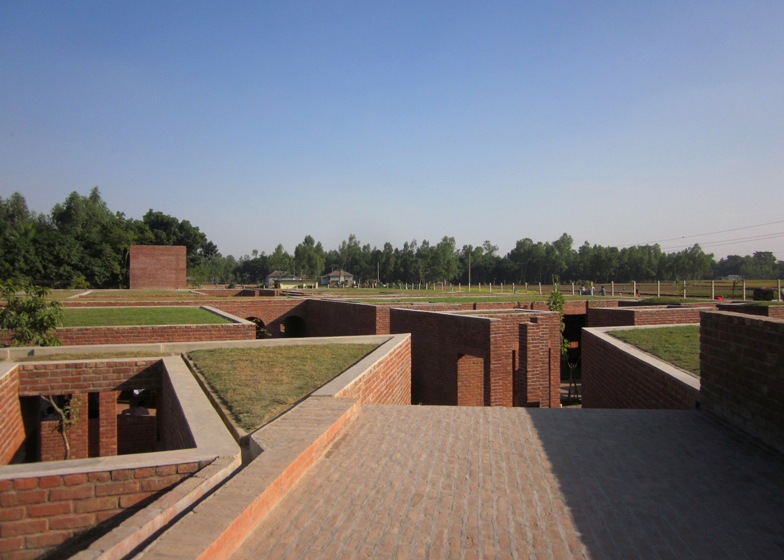A labyrinth of brick walls, arches and courtyards are protected from flooding behind a man-made embankment at this open-air community centre in rural Bangladesh (+ slideshow).
Designed by Bangladeshi architect and URBANA founder Kashef Mahboob Chowdhury, the complex functions as the centre for a charitable organisation. It offers training programmes for the poorest individuals in Gaibandha, a town where most of the community are employed in agriculture.
The Friendship Centre is built on low-lying land surrounded by fields. Despite the threat of flooding, the cost of raising the building above the flood plain was too great so instead the designers created their own defence by building up the earth surrounding the site.
Each building within the complex is constructed from a uniform brickwork, creating a maze of pavilion-like structures. Each block has the same height and every rooftop is covered with grass.
"In the extreme limitation of means was a search for the luxury of light and shadows, of the economy and generosity of small spaces and of the joy of movement and discovery in the bare and the essential," said Chowdhury.
The architect also compares the project to some of the ancient Buddhist monasteries constructed elsewhere in the region. "Simplicity is the intent, monastic is the feel," he added.
Rooms are divided into two zones to separate reception and training rooms from dormitories and other more private quarters. There's also a library, a conference room, a prayer space and a small shop.
Large openings in the walls bring natural light and ventilation through the buildings, while a sequence of small courtyards and pools allow cool air to circulate.
Excessive rainwater is collected in some of these pools and pumped into a nearby pond, while a complex network of septic tanks and wells prevents sewage mixing with flood water.
Other projects designed to combat possible flooding include a floating house in New Orleans and a whole neighbourhood in Copenhagen.
Here's more text from the design team:
Friendship Centre
The Friendship Centre near the district town of Gaibandha, Bangladesh, is for an NGO which works with some of the poorest in the country and who live mainly in riverine islands (chars) with very limited access and opportunities. Friendship uses the facility for its own training programs and will also rent out for meetings, training, conferences etc. as income generation.
The low-lying land, which is located in rural Gaibandha where agriculture is predominant, is under threat of flooding if the embankment encircling the town and peripheries break.
An extensive program with a very limited fund meant that raising the structures above flood level (a height of eight feet) was not an option: nearly the entire available fund would be lost below grade. Being in an earthquake zone and the low bearing capacity of the silty soil added further complications. The third and final design relies on a surrounding embankment for flood protection while building directly on existing soil, in load-bearing masonry. Rainwater and surface run-off are collected in internal pools and the excess is pumped to an excavated pond, also to be used for fishery. The design relies on natural ventilation and cooling, being facilitated by courtyards and pools and the earth covering on roofs. An extensive network of septic tanks and soak wells ensure the sewage does not mix with flood water.
The 'Ka' Block contains the reception pavilion, offices, library, training/conference rooms and pavilions, a prayer space and a small 'cha-shop'. The 'Kha' Block, connected by three archways, is for more private functions and houses the dormitories, the dining pavilion and staff and family quarters. The laundry and drying shed is located on the other side of the pond. There is no air-conditioning and the entire lighting is through LED and energy efficient lamps.
As in construction, so in conception - the complex of the centre rise and exist as echo of ruins, alive with the memory of the remains of Mahasthan (3rd century BC), some sixty kilometres away. Constructed and finished primarily of one material - local hand-made bricks - the spaces arc woven out of pavilions, courtyards, pools and greens; corridors and shadows. Simplicity is the intent, monastic is the feel.
The centre serves and brings together some of the poorest of poor in the country and, by extension, in the world, yet in the extreme limitation of means was a search for the luxury of light and shadows of the economy and generosity of small spaces; of the joy of movement and discovery in the bare and the essential.






